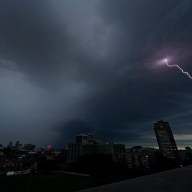CALGARY – A federal report that suggests there’s no chance grizzly bears that once roamed the tall grass of the Prairies can be recovered in the region sends a sobering warning, says a group that is trying to protect the bruins.
The Environment Canada report compiled under the Species at Risk Act says the landscape of the southern Prairies has irreversibly changed since the bears’ range stretched as far east as Manitoba hundreds of years ago.
Where bears once lived amongst wild bison and flowing grasslands, people and roads are now packed tightly around agricultural fields, leaving little land where modern grizzlies could survive.
“It highlights a rather tragic reality that once a species is lost, more often than not it’s lost forever,” Carl Morrison of the group Action Grizzly Bear said Monday.
Grizzlies are considered extirpated, or extinct within a certain region, in a Prairie zone that stretches from just east of Winnipeg, up over top of Saskatoon and Edmonton and just west of Calgary.
Anecdotal information from early European settlers suggest that bears were once fairly plentiful, but “grizzly bears were rarely seen on the Canadian Prairies after 1900,” according to the report, which was released late last month.
“Recovery of this species is considered not technically or biologically feasible at this time,” it concludes.
Modern-day grizzlies mainly live in an area from the Rocky Mountain foothills stretching north.
Without stronger protection, their range could become even smaller, said Morrison. Some sources suggest as few as 500 bears could be left in Alberta.
“The report concludes that we can’t recover the Prairie population of grizzly bears, so in order to maintain healthy and viable populations of grizzly bears in Canada we need to focus on areas where they still exist,” he said.
“If we don’t want this trend to continue … then the government of Alberta needs to take some action to make sure that it stops here.”
The report suggests that individual bears do sometimes stray into the Alberta prairie, but they probably only stay during non-drought years and wouldn’t reach anywhere near the number needed to rebuild a population.
Other reports have suggested that individual bears may be venturing into northern Manitoba, prompting calls for stricter protection in that province as well.
Morrison said the Alberta government needs to immediately list the bears as threatened, something that was recommended by a government group in 2002 when their numbers slipped below 1,000.
The government has been waiting for the result of a four-year-long DNA count of the bruins before making a decision, said spokesman Dave Ealey.
That report should be released very soon, he said.
“A large part of the rationale for it being looked at as threatened is doubt about the population numbers,” he said.
The count could also affect a decision on whether to lift a temporary moratorium on hunting the bears in the province, something Sustainable Resource Minister Ted Morton has said would be decided by the end of the year.
Ealey added that it’s impossible to compare a report looking at grizzlies living 150 years ago in completely different circumstances to grizzlies living today.
The government has taken action on protecting the remaining bears in the province, including through initiatives aimed at reducing human-bear interactions, said Ealey.
Morrison said Alberta needs to include grizzly bear recovery in the province as “a line item” in the next budget. Humans and bears can live together, he said, but encroachment into grizzly bear territory needs to be carefully managed so that humans aren’t moving in at a level the bears can’t handle.
“We need to step it up to make sure that grizzly bears can utilize that habitat for the long term.”













